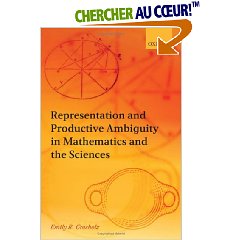Accueil > Archives > Publications 2000–2008 > Ouvrages parus 2003-2008 > Representation and Productive Ambiguity in Mathematics and the Sciences
Representation and Productive Ambiguity in Mathematics and the Sciences

Emily R. Grosholz, enseignant-chercheur à l’université de Pennsylvanie
Oxford University Press, USA, 30 août 2007, 250 p.
Book Description
Emily Grosholz offers an original investigation of demonstration in mathematics and science, examining how it works and why it is persuasive. Focusing on geometrical demonstration, she shows the roles that representation and ambiguity play in mathematical discovery. She presents a wide range of case studies in mechanics, topology, algebra, logic, and chemistry, from ancient Greece to the present day, but focusing particularly on the seventeenth and twentieth centuries. She argues
that reductive methods are effective not because they diminish but because they multiply and juxtapose modes of representation. Such problem-solving is, she argues, best understood in terms of Leibnizian ’analysis’ - the search for conditions of intelligibility. Discovery and justification are then two aspects of one rational way of proceeding, which produces the mathematician’s formal experience.
Grosholz defends the importance of iconic, as well as symbolic and indexical, signs in mathematical representation, and argues that pragmatic, as well as syntactic and semantic, considerations are indispensable for mathematical reasoning. By taking a close look at the way results are presented on the page in mathematical (and biological, chemical, and mechanical) texts, she shows that when two or more traditions combine in the service of problem solving, notations and diagrams are sublty
altered, multiplied, and juxtaposed, and surrounded by prose in natural language which explains the novel combination. Viewed this way, the texts yield striking examples of language and notation that are irreducibly ambiguous and productive because they are ambiguous. Grosholtz’s arguments, which invoke Descartes, Locke, Hume, and Kant, will be of considerable interest to philosophers and historians of mathematics and science, and also have far-reaching consequences for epistemology
and philosophy o
language.
Dans la même rubrique :
- Des coléoptères, des collections et des hommes
- Worlds of flow
- L’analogie dans la démarche scientifique
- Les mathématiques dans la cité
- La Quadrature du cercle. Un problème à la mesure des Lumières
- Expounding the Mathematical Seed : The Supplements, A translation of Bhâskara I on the Mathematical Chapter of the Aryabhatiya [Volume 1 : The Translation et Volume 2 : The Supplements]
- Médecine et sciences humaines : Manuel pour les études médicales
- History of mathematical sciences - Portugal and East Asia III - The Jesuits, The Padroado and East Asian Science (1552-1773)
- Formación de cultura científica en Colombia. Ensayos sobre matemática y física
- Newton et les origines de l’analyse : 1664-1666
- Nombres : éléments de mathématiques pour philosophes
- Philosophie, science, histoire. Michel Paty et le Brésil, en hommage pour 40 années de collaboration
- Tablettes mathématiques de Nippur
- Estudos de filosofia e história das ciências biomédicas
- Voyage à Montbard
- Buffon - Œuvres
- Les forces vitales et leur distribution dans la nature. Un essai de "systématique physiologique"
- Aux origines de la biologie moderne : L’anatomie comparée d’Aristote à la théorie de l’évolution
- Histoire d’une question anatomique : la répétition des parties
- Retours sur l’affaire Sokal





